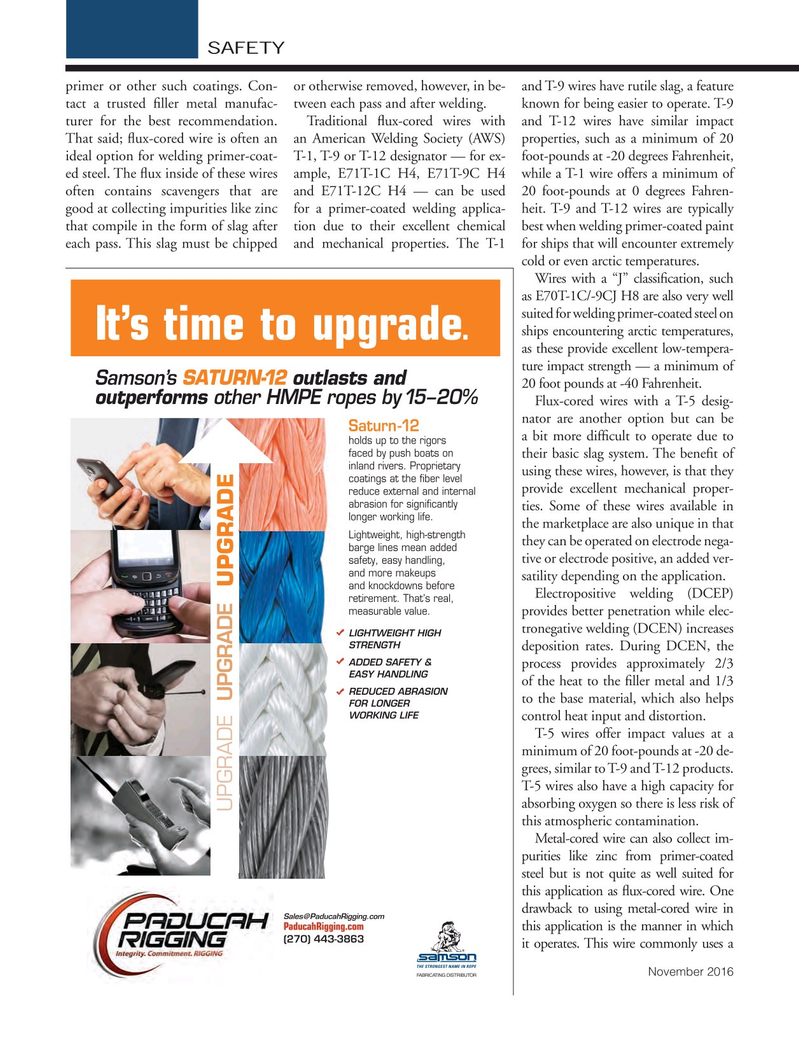
Page 36: of Marine News Magazine (November 2016)
Workboat Annual
Read this page in Pdf, Flash or Html5 edition of November 2016 Marine News Magazine
SAFETY primer or other such coatings. Con- or otherwise removed, however, in be- and T-9 wires have rutile slag, a feature tact a trusted ? ller metal manufac- tween each pass and after welding. known for being easier to operate. T-9 turer for the best recommendation. Traditional ? ux-cored wires with and T-12 wires have similar impact
That said; ? ux-cored wire is often an an American Welding Society (AWS) properties, such as a minimum of 20 ideal option for welding primer-coat- T-1, T-9 or T-12 designator — for ex- foot-pounds at -20 degrees Fahrenheit, ed steel. The ? ux inside of these wires ample, E71T-1C H4, E71T-9C H4 while a T-1 wire offers a minimum of often contains scavengers that are and E71T-12C H4 — can be used 20 foot-pounds at 0 degrees Fahren- good at collecting impurities like zinc for a primer-coated welding applica- heit. T-9 and T-12 wires are typically that compile in the form of slag after tion due to their excellent chemical best when welding primer-coated paint each pass. This slag must be chipped and mechanical properties. The T-1 for ships that will encounter extremely cold or even arctic temperatures.
Wires with a “J” classi? cation, such as E70T-1C/-9CJ H8 are also very well suited for welding primer-coated steel on ships encountering arctic temperatures,
It’s time to upgrade.
as these provide excellent low-tempera- ture impact strength — a minimum of
Samson’s SATURN-12 outlasts and 20 foot pounds at -40 Fahrenheit. outperforms other HMPE ropes by 15–20%
Flux-cored wires with a T-5 desig- nator are another option but can be
S Saturn-12 a bit more dif? cult to operate due to h holds up to the rigors fa faced by push boats on their basic slag system. The bene? t of in inland rivers. Proprietary using these wires, however, is that they c coatings at the ?ber level provide excellent mechanical proper- re reduce external and internal a abrasion for signi?cantly ties. Some of these wires available in lo longer working life.
the marketplace are also unique in that
L L Li Lightweight, high-strength they can be operated on electrode nega- ba barge lines mean added tive or electrode positive, an added ver- sa safety, easy handling, an and more makeups satility depending on the application.
UPGRADE an and knockdowns before
Electropositive welding (DCEP) re retirement. That’s real, m measurable value.
provides better penetration while elec- tronegative welding (DCEN) increases
LI LIGHTWEIGHT HIGH
ST STRENGTH deposition rates. During DCEN, the
ADDED SAFETY & process provides approximately 2/3
EASY HANDLING of the heat to the ? ller metal and 1/3
REDUCED ABRASION to the base material, which also helps
FOR LONGER
WORKING LIFE control heat input and distortion.
T-5 wires offer impact values at a minimum of 20 foot-pounds at -20 de- grees, similar to T-9 and T-12 products.
T-5 wires also have a high capacity for absorbing oxygen so there is less risk of
UPGRADE UPGRADE this atmospheric contamination.
Metal-cored wire can also collect im- purities like zinc from primer-coated steel but is not quite as well suited for this application as ? ux-cored wire. One drawback to using metal-cored wire in
PaducahRigging.com this application is the manner in which (270) 443-3863 it operates. This wire commonly uses a
November 2016
MN Nov16 Layout 32-49.indd 36 10/21/2016 2:29:51 PM

 35
35

 37
37
